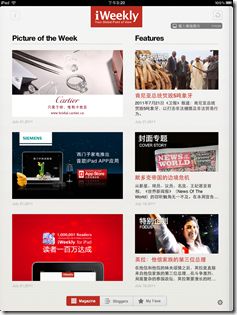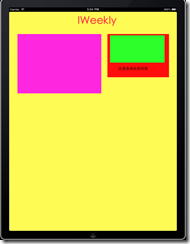今天跟旺才兄学习了一下UIView的setNeedsDisplay和setNeedsLayout方法。首先两个方法都是异步执行的。而setNeedsDisplay会调用自动调用drawRect方法,这样可以拿到UIGraphicsGetCurrentContext,就可以画画了。而setNeedsLayout会默认调用layoutSubViews,就可以处理子视图中的一些数据。
宗上所诉,setNeedsDisplay方便绘图,而layoutSubViews方便出来数据。
\
ipad横竖屏切换解决方案
2011年08月01日 星期一 10:09
由于ipad的横竖屏不同,所以好的应用,横竖屏的页面布局也不一样。那么就需要横竖屏的整体解决方案。先看一个横竖屏布局不一样的界面。  
上面两张图是来自同一个界面的横竖版的截屏。可以看出,横竖版显示的内容相同,但是界面布局不同。要实现上述布局,主要是运用UIView中 layoutSubviews方法。当UIView设置为自动适配屏幕时,当用户旋转设备的时候,会调用layoutSubviews方法,我们只需重写 这个方法,然后判断用户屏幕的方向。在调整每个空间的位置即可。 下面是实现上述界面的最简单的原型: 事例的截图如下:  

在ContentView中重写layoutSubviews方法,然后根据stausbar的方向判断当前视图的横竖屏。具体代码:
-(void)layoutSubviews{
[super layoutSubviews];
UIDeviceOrientation interfaceOrientation=[[UIApplication sharedApplication] statusBarOrientation];
if (interfaceOrientation == UIDeviceOrientationPortrait || interfaceOrientation == UIDeviceOrientationPortraitUpsideDown) {
//翻转为竖屏时
[self setVerticalFrame];
}else if (interfaceOrientation==UIDeviceOrientationLandscapeLeft || interfaceOrientation == UIDeviceOrientationLandscapeRight) {
//翻转为横屏时
[self setHorizontalFrame];
}
} -(void)setVerticalFrame
{
NSLog(@"竖屏");
[titleLable setFrame:CGRectMake(283, 0, 239, 83)];
[leftView setFrame:CGRectMake(38, 102, 384, 272)];
[rightView setFrame:CGRectMake(450, 102, 282, 198)];
} -(void)setHorizontalFrame
{
NSLog(@"横屏");
[titleLable setFrame:CGRectMake(183, 0, 239, 83)];
[leftView setFrame:CGRectMake(168, 122, 384, 272)];
[rightView setFrame:CGRectMake(650, 122, 282, 198)];
}
在具体的横竖屏方法中,从新设置各个组件的坐标即可。 接下来在ContentView中添加ArticleView视图。
-(id)initWithCoder:(NSCoder *)aDecoder
{
if ((self = [super initWithCoder:aDecoder])) { NSArray *arrayContentView =[[NSBundle mainBundle] loadNibNamed:@"ArticleView" owner:self options:nil];
rightView=[arrayContentView objectAtIndex:0];
[self addSubview:rightView];
}
return self;
}
由于我用的是xib,所以初始化方法为initWithCoder,在这个中添加新的视图。 同样在ArticleView中设置横竖屏相应空间的坐标即可。
-(void)layoutSubviews{
[super layoutSubviews];
UIDeviceOrientation interfaceOrientation=[[UIApplication sharedApplication] statusBarOrientation];
CGRect rect=self.frame;
rect.size.width=282;
rect.size.height=198;
[self setFrame:rect];
if (interfaceOrientation == UIDeviceOrientationPortrait || interfaceOrientation == UIDeviceOrientationPortraitUpsideDown) {
//翻转为竖屏时
[self setVerticalFrame];
}else if (interfaceOrientation==UIDeviceOrientationLandscapeLeft || interfaceOrientation == UIDeviceOrientationLandscapeRight) {
//翻转为横屏时
[self setHorizontalFrame];
}
} -(void)setVerticalFrame
{
NSLog(@"竖屏");
[contentView setFrame:CGRectMake(12, 6, 250, 125)];
[textLable setFrame:CGRectMake(50, 139, 182, 39)];
} -(void)setHorizontalFrame
{
NSLog(@"横屏");
[contentView setFrame:CGRectMake(12, 6, 106, 158)];
[textLable setFrame:CGRectMake(135, 11, 147, 39)];
}
|





